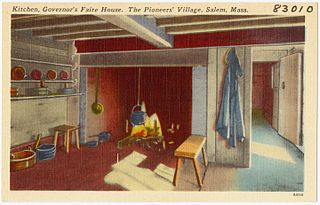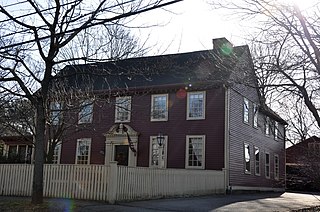Related Research Articles

Salem is a historic coastal city in Essex County, Massachusetts, United States, located on the North Shore of Greater Boston. Continuous settlement by Europeans began in 1626 with English colonists. Salem was one of the most significant seaports trading commodities in early American history. Prior to the dissolution of county governments in Massachusetts in 1999, it served as one of two county seats for Essex County, alongside Lawrence.

The Massachusetts Bay Colony (1628–1691), more formally the Colony of Massachusetts Bay, was an English settlement on the east coast of North America around the Massachusetts Bay, one of the several colonies later reorganized as the Province of Massachusetts Bay. The lands of the settlement were in southern New England, with initial settlements on two natural harbors and surrounding land about 15.4 miles (24.8 km) apart—the areas around Salem and Boston, north of the previously established Plymouth Colony. The territory nominally administered by the Massachusetts Bay Colony covered much of central New England, including portions of Massachusetts, Maine, New Hampshire, and Connecticut.
John Hathorne was a merchant and magistrate of the Massachusetts Bay Colony and Salem, Massachusetts. He is best known for his early and vocal role as one of the leading judges in the Salem witch trials.

Cape Ann is a rocky peninsula in northeastern Massachusetts on the Atlantic Ocean. It is about 30 miles (48 km) northeast of Boston and marks the northern limit of Massachusetts Bay. Cape Ann includes the city of Gloucester and the towns of Essex, Manchester-by-the-Sea and Rockport.

The Winthrop Fleet was a group of 11 ships led by John Winthrop out of a total of 16 funded by the Massachusetts Bay Company which together carried between 700 and 1,000 Puritans plus livestock and provisions from England to New England over the summer of 1630, during the first period of the Great Migration.
Francis Higginson (1588–1630) was an early Puritan minister in Colonial New England, and the first minister of Salem, Massachusetts. He was an ancestor of Thomas Wentworth Higginson.
The 'Dorchester Company' of Adventurers was a Joint Stock Company established in 1623 in England to enable the English colonisation of North America It was based in Dorchester, Dorset, near the English Channel, and was founded at the instigation of the puritan Anglican churchman, John White. The company was a commercial organisation which aimed to provide a safe haven on the North American Coast where supplies could be stored. This was established at Cape Ann.

Roger Conant was a New England colonist and drysalter credited for establishing the communities of Salem, Peabody, Beverly and Danvers, Massachusetts.

Pioneer Village, also known as Salem 1630: Pioneer Village, is a living history museum recreating the city of Salem as it was in the 17th century. Opened in June 1930, it was the first museum of its kind in the United States.
The Pawtucket tribe were a confederation of Eastern Algonquian-speaking Native Americans in present-day northeastern Massachusetts and southeastern New Hampshire. They are mostly known in the historical record for their dealings with the early English colonists in the 17th century. Confusion exists about the proper endonym for this group who are variously referred to in European documents as Pawtucket, Pentucket, Naumkeag, Wamesit, or Mystic Indians, or by the name of their current sachem or sagamore.

The Exercise Conant House is a historic First Period house in Beverly, Massachusetts, United States. Most of this 2.5-story wood-frame house was built after 1715 for the Reverend John Chipman, and contains many fine Georgian features. Attached to its north side is a two-story single-room ell that dates to c. 1695, and was probably built by Exercise Conant, son of early Cape Ann settler Roger Conant.

The New England Colonies of British America included Connecticut Colony, the Colony of Rhode Island and Providence Plantations, Massachusetts Bay Colony, Plymouth Colony, and the Province of New Hampshire, as well as a few smaller short-lived colonies. The New England colonies were part of the Thirteen Colonies and eventually became five of the six states in New England, with Plymouth Colony absorbed into Massachusetts and Maine separating from it.

Naumkeag is a historical tribe of Eastern Algonquian-speaking Native American people who lived in northeastern Massachusetts. They controlled most of the territory from the Charles River to the Merrimack River at the time of the Puritan migration to New England (1620–1640).
William Phelps, was a Puritan who emigrated from Crewkerne, England in 1630, one of the founders of both Dorchester, Boston Massachusetts and Windsor, Connecticut, and one of eight selected to lead the first democratic town government in the American colonies in 1637. He was foreman of the first grand jury in New England, served most of his life in early colonial government, and according to noted historian Henry Reed Stiles, Phelps "was one of the most prominent and highly respected men in the colony."

John White was an English clergyman, the rector of a parish in Dorchester, Dorset. He was instrumental in obtaining charters for the New England Company and the Massachusetts Bay Company. He took a personal interest in the settlement of New England.

The Agawam were an Algonquian Native American people inhabiting the coast of New England encountered by English colonists who arrived in the early 17th century. Decimated by pestilence shortly before the English colonization and fearing attacks from their hereditary enemies among the Abenaki and other tribes of present-day Maine, they invited the English to settle with them on their tribal territory.
Masconomet, spelled many different ways in colonial deeds, was sagamore of the Agawam tribe among the Algonquian peoples during the time of the English colonization of the Americas. He is known for his quitclaim deed ceding all the tribal land, which extended from Cape Ann to the Merrimack River, as far inland as North Andover, Massachusetts and Middleton, Massachusetts, and as far to the southwest as the Danvers River, to John Winthrop the Younger, his heirs and all the settlers of eastern Essex County for a sum of 20 pounds, about 100 dollars.
Thomas Gardner was an Overseer of the "old planters" party of the Dorchester Company who landed in 1624 at Cape Ann to form a colony at what is now known as Gloucester. Gardner is considered by some to have been the first Governor of Massachusetts, due to his being in authority in the first settlement that became the Massachusetts Bay Colony.
Great House in Cape Ann was a seventeenth century structure built by colonists in present-day Gloucester, Massachusetts. It was later disassembled and moved to Salem, Massachusetts, to be the Governor's house.
Mary and John was a 400-ton ship that is known to have sailed between England and the American colonies four times from 1607 to 1634. Named in tribute to John and Mary Winthrop she was captained by Robert Davies and owned by Roger Ludlow (1590–1664), one of the assistants of the Massachusetts Bay Colony. The ship's first two voyages to North America were to what is now Maine in June 1607 and September 1608, transporting emigrants to the colonies and back to England. In 1609, Samuel Argall also used the ship to navigate a shorter route to the Colony of Virginia via Bermuda. The third voyage to Maine was on March 20, 1630, bearing 130 colonists, and the fourth on March 26, 1634, to Nantaskut in the Massachusetts Bay Colony.
References
- Arrington, Benjamin (1922). Municipal History of Essex County in Massachusetts. Lewis Historical Publishing Company.
- Fiske, John (1899). The Beginnings of New England. Houghton, Mifflin and Company.
- Goff, John (2009). Salem's Witch House: A Touchstone to Antiquity. The History Press. ISBN 9781596295193.
- Higginson, Thomas (1891). Life of Francis Higginson, First Minister in the Massachusetts Bay Colony. Dodd, Mead, & Co., New York.